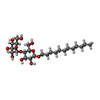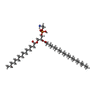[English] 日本語
 Yorodumi
Yorodumi- EMDB-18670: Cryo-EM structure of Cx26 from Gallus Gallus in bicarbonate buffer -
+ Open data
Open data
- Basic information
Basic information
| Entry |  | |||||||||
|---|---|---|---|---|---|---|---|---|---|---|
| Title | Cryo-EM structure of Cx26 from Gallus Gallus in bicarbonate buffer | |||||||||
 Map data Map data | Full map D6 averaged | |||||||||
 Sample Sample |
| |||||||||
 Keywords Keywords | Gap junction Large Pore Channel Carbon dioxide sensitive / MEMBRANE PROTEIN | |||||||||
| Function / homology |  Function and homology information Function and homology informationGap junction assembly / gap junction-mediated intercellular transport / connexin complex / gap junction channel activity / sensory perception of sound / cell-cell signaling Similarity search - Function | |||||||||
| Biological species |  | |||||||||
| Method | single particle reconstruction / cryo EM / Resolution: 2.07 Å | |||||||||
 Authors Authors | Brotherton DH / Cameron AD | |||||||||
| Funding support |  United Kingdom, 2 items United Kingdom, 2 items
| |||||||||
 Citation Citation |  Journal: J Physiol / Year: 2025 Journal: J Physiol / Year: 2025Title: Multiple carbamylation events are required for differential modulation of Cx26 hemichannels and gap junctions by CO. Authors: Sarbjit Nijjar / Deborah Brotherton / Jack Butler / Valentin-Mihai Dospinescu / Harry G Gannon / Victoria Linthwaite / Martin Cann / Alexander Cameron / Nicholas Dale /  Abstract: CO directly modifies the gating of connexin26 (Cx26) gap junction channels and hemichannels. This gating depends upon Lys125, and the proposed mechanism involves carbamylation of Lys125 to allow ...CO directly modifies the gating of connexin26 (Cx26) gap junction channels and hemichannels. This gating depends upon Lys125, and the proposed mechanism involves carbamylation of Lys125 to allow formation of a salt bridge with Arg104 on the neighbouring subunit. We demonstrate via carbamate trapping and tandem mass spectrometry that five Lys residues within the cytoplasmic loop, including Lys125, are indeed carbamylated by CO. The cytoplasmic loop appears to provide a chemical microenvironment that facilitates carbamylation. Systematic mutation of these Lys residues to Arg shows that only carbamylation of Lys125 is essential for hemichannel opening. By contrast, carbamylation of Lys108 and Lys125 is essential for gap junction closure to CO. Chicken (Gallus gallus) Cx26 gap junction channels lack Lys108 and do not close to CO, as shown by both a dye transfer assay and a high-resolution cryogenic electron microscopy structure. The mutation Lys108Arg prevents CO-dependent gap junction channel closure in human Cx26. Our findings directly demonstrate carbamylation in connexins, provide further insight into the differential action of CO on Cx26 hemichannels and gap junction channels, and increase support for the role of the N-terminus in gating the Cx26 channel. KEY POINTS: Direct evidence of carbamylation of multiple lysine residues in the cytoplasmic loop of Cx26. Concentration-dependent carbamylation at lysines 108, 122 and 125. Only carbamylation of lysine 125 is essential for hemichannel opening to CO. Carbamylation of lysine 108 along with lysine 125 is essential for CO-dependent gap junction channel closure. | |||||||||
| History |
|
- Structure visualization
Structure visualization
| Supplemental images |
|---|
- Downloads & links
Downloads & links
-EMDB archive
| Map data |  emd_18670.map.gz emd_18670.map.gz | 249.2 MB |  EMDB map data format EMDB map data format | |
|---|---|---|---|---|
| Header (meta data) |  emd-18670-v30.xml emd-18670-v30.xml emd-18670.xml emd-18670.xml | 22.8 KB 22.8 KB | Display Display |  EMDB header EMDB header |
| FSC (resolution estimation) |  emd_18670_fsc.xml emd_18670_fsc.xml | 15.3 KB | Display |  FSC data file FSC data file |
| Images |  emd_18670.png emd_18670.png | 80.1 KB | ||
| Filedesc metadata |  emd-18670.cif.gz emd-18670.cif.gz | 7 KB | ||
| Others |  emd_18670_half_map_1.map.gz emd_18670_half_map_1.map.gz emd_18670_half_map_2.map.gz emd_18670_half_map_2.map.gz | 250.2 MB 250.2 MB | ||
| Archive directory |  http://ftp.pdbj.org/pub/emdb/structures/EMD-18670 http://ftp.pdbj.org/pub/emdb/structures/EMD-18670 ftp://ftp.pdbj.org/pub/emdb/structures/EMD-18670 ftp://ftp.pdbj.org/pub/emdb/structures/EMD-18670 | HTTPS FTP |
-Validation report
| Summary document |  emd_18670_validation.pdf.gz emd_18670_validation.pdf.gz | 164.9 KB | Display |  EMDB validaton report EMDB validaton report |
|---|---|---|---|---|
| Full document |  emd_18670_full_validation.pdf.gz emd_18670_full_validation.pdf.gz | 164.4 KB | Display | |
| Data in XML |  emd_18670_validation.xml.gz emd_18670_validation.xml.gz | 570 B | Display | |
| Data in CIF |  emd_18670_validation.cif.gz emd_18670_validation.cif.gz | 484 B | Display | |
| Arichive directory |  https://ftp.pdbj.org/pub/emdb/validation_reports/EMD-18670 https://ftp.pdbj.org/pub/emdb/validation_reports/EMD-18670 ftp://ftp.pdbj.org/pub/emdb/validation_reports/EMD-18670 ftp://ftp.pdbj.org/pub/emdb/validation_reports/EMD-18670 | HTTPS FTP |
-Related structure data
| Related structure data |  8qvnMC M: atomic model generated by this map C: citing same article ( |
|---|---|
| Similar structure data | Similarity search - Function & homology  F&H Search F&H Search |
- Links
Links
| EMDB pages |  EMDB (EBI/PDBe) / EMDB (EBI/PDBe) /  EMDataResource EMDataResource |
|---|
- Map
Map
| File |  Download / File: emd_18670.map.gz / Format: CCP4 / Size: 316.2 MB / Type: IMAGE STORED AS FLOATING POINT NUMBER (4 BYTES) Download / File: emd_18670.map.gz / Format: CCP4 / Size: 316.2 MB / Type: IMAGE STORED AS FLOATING POINT NUMBER (4 BYTES) | ||||||||||||||||||||||||||||||||||||
|---|---|---|---|---|---|---|---|---|---|---|---|---|---|---|---|---|---|---|---|---|---|---|---|---|---|---|---|---|---|---|---|---|---|---|---|---|---|
| Annotation | Full map D6 averaged | ||||||||||||||||||||||||||||||||||||
| Projections & slices | Image control
Images are generated by Spider. | ||||||||||||||||||||||||||||||||||||
| Voxel size | X=Y=Z: 0.85 Å | ||||||||||||||||||||||||||||||||||||
| Density |
| ||||||||||||||||||||||||||||||||||||
| Symmetry | Space group: 1 | ||||||||||||||||||||||||||||||||||||
| Details | EMDB XML:
|
-Supplemental data
-Half map: Half map D6 averaged
| File | emd_18670_half_map_1.map | ||||||||||||
|---|---|---|---|---|---|---|---|---|---|---|---|---|---|
| Annotation | Half map D6 averaged | ||||||||||||
| Projections & Slices |
| ||||||||||||
| Density Histograms |
-Half map: Half map D6 averaged
| File | emd_18670_half_map_2.map | ||||||||||||
|---|---|---|---|---|---|---|---|---|---|---|---|---|---|
| Annotation | Half map D6 averaged | ||||||||||||
| Projections & Slices |
| ||||||||||||
| Density Histograms |
- Sample components
Sample components
-Entire : Connexin 26 (Gallus Gallus) in 90mmHg PCO2, pH7.4
| Entire | Name: Connexin 26 (Gallus Gallus) in 90mmHg PCO2, pH7.4 |
|---|---|
| Components |
|
-Supramolecule #1: Connexin 26 (Gallus Gallus) in 90mmHg PCO2, pH7.4
| Supramolecule | Name: Connexin 26 (Gallus Gallus) in 90mmHg PCO2, pH7.4 / type: complex / ID: 1 / Parent: 0 / Macromolecule list: #1 |
|---|---|
| Source (natural) | Organism:  |
-Macromolecule #1: Gap junction protein
| Macromolecule | Name: Gap junction protein / type: protein_or_peptide / ID: 1 / Number of copies: 12 / Enantiomer: LEVO |
|---|---|
| Source (natural) | Organism:  |
| Molecular weight | Theoretical: 26.264119 KDa |
| Recombinant expression | Organism:  |
| Sequence | String: MDWGTLQAVL GGVNKHSTSI GKIWLTVLFI FRIMILVVAA ERVWGDEQQD FVCNTLQPGC RNVCYDHFFP ISHIRLWALQ LIFVSTPAL LVAMHVAYTR HERKRRFRSG DKINIEELKN EKIHIRGPLW WTYTCSIFFR IVFEAVFMYV FYYMYDGYQM P RLVKCDAW ...String: MDWGTLQAVL GGVNKHSTSI GKIWLTVLFI FRIMILVVAA ERVWGDEQQD FVCNTLQPGC RNVCYDHFFP ISHIRLWALQ LIFVSTPAL LVAMHVAYTR HERKRRFRSG DKINIEELKN EKIHIRGPLW WTYTCSIFFR IVFEAVFMYV FYYMYDGYQM P RLVKCDAW PCPNVVDCFV SRPTEKTTFT IFMLAVSGIC MMLNLAELCY LVIKVCLKDS GKTTVLK UniProtKB: Gap junction protein |
-Macromolecule #2: DODECYL-BETA-D-MALTOSIDE
| Macromolecule | Name: DODECYL-BETA-D-MALTOSIDE / type: ligand / ID: 2 / Number of copies: 24 / Formula: LMT |
|---|---|
| Molecular weight | Theoretical: 510.615 Da |
| Chemical component information |  ChemComp-LMT: |
-Macromolecule #3: PHOSPHATIDYLETHANOLAMINE
| Macromolecule | Name: PHOSPHATIDYLETHANOLAMINE / type: ligand / ID: 3 / Number of copies: 24 / Formula: PTY |
|---|---|
| Molecular weight | Theoretical: 734.039 Da |
| Chemical component information |  ChemComp-PTY: |
-Macromolecule #4: water
| Macromolecule | Name: water / type: ligand / ID: 4 / Number of copies: 466 / Formula: HOH |
|---|---|
| Molecular weight | Theoretical: 18.015 Da |
| Chemical component information |  ChemComp-HOH: |
-Experimental details
-Structure determination
| Method | cryo EM |
|---|---|
 Processing Processing | single particle reconstruction |
| Aggregation state | particle |
- Sample preparation
Sample preparation
| Concentration | 3 mg/mL | |||||||||||||||||||||||||||
|---|---|---|---|---|---|---|---|---|---|---|---|---|---|---|---|---|---|---|---|---|---|---|---|---|---|---|---|---|
| Buffer | pH: 7.4 Component:
Details: The buffer, except DDM and DTT, was prepared fresh from 10x stock on day of used. The basal buffer was filtered and degassed and DDM and DTT added. The buffer was pH corrected at point of ...Details: The buffer, except DDM and DTT, was prepared fresh from 10x stock on day of used. The basal buffer was filtered and degassed and DDM and DTT added. The buffer was pH corrected at point of use to pH 7.4 using 15% CO2 in 85% N2. | |||||||||||||||||||||||||||
| Vitrification | Cryogen name: ETHANE-PROPANE / Instrument: LEICA EM GP Details: 3 microlitres protein applied to grid, blot time 7 seconds, in 15% CO2/85%N2 atmosphere. |
- Electron microscopy
Electron microscopy
| Microscope | FEI TITAN KRIOS |
|---|---|
| Specialist optics | Energy filter - Name: GIF Bioquantum |
| Image recording | Film or detector model: GATAN K3 (6k x 4k) / Number real images: 8713 / Average exposure time: 3.0 sec. / Average electron dose: 41.0 e/Å2 |
| Electron beam | Acceleration voltage: 300 kV / Electron source:  FIELD EMISSION GUN FIELD EMISSION GUN |
| Electron optics | Illumination mode: FLOOD BEAM / Imaging mode: BRIGHT FIELD / Cs: 2.7 mm / Nominal defocus max: 2.0 µm / Nominal defocus min: 0.8 µm / Nominal magnification: 105000 |
| Sample stage | Specimen holder model: FEI TITAN KRIOS AUTOGRID HOLDER |
| Experimental equipment |  Model: Titan Krios / Image courtesy: FEI Company |
 Movie
Movie Controller
Controller



 Z (Sec.)
Z (Sec.) Y (Row.)
Y (Row.) X (Col.)
X (Col.)






































